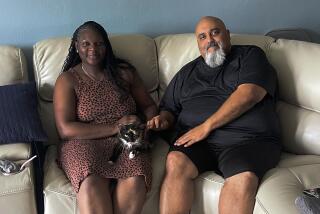Pet Project: Get Tracking Chip Implanted in Spot and Fluffy
- Share via
Rocky’s not a dog who lacks for anything.
Our family’s 110-pound golden retriever has been the center of my parents’ household since he moved into their empty nest about six years ago. So it’s no wonder, really, that the dog with his own lounge chair by the pool is also now equipped with his very own microchip.
If Rocky is ever crazy enough to run away, the chip injected into the loose skin at the back of his neck could be scanned at any animal shelter--and many veterinarian offices--in Southern California and beyond. If his personal ID number were to pop up on the hand-held scanner, the shelter would be able to locate Rocky’s family in a national database of pet owners. If the dog had allergies or medical needs, that information would pop up as well.
Los Angeles started implanting the chips--which are about the size of a grain of rice--in dogs and cats at city shelters in June. The city recovers an average of 45 lost pets a day using the technology, according to Michael Burns, the director of shelter programs for AVID Identification Systems Inc. of Norco.
AVID has the contracts to supply the cities of L.A., San Diego and Sacramento with their chips and scanners. Another company, called Home Again, offers a competing product in conjunction with the American Kennel Club.
AVID has registered about 7 million pets nationwide. Home Again says it has about 700,000 pets in its database. The two systems are compatible with each other, so scanners from either company can help bring Spot home again. The chips cost as much as about $50 each (less at animal shelters), and registering your pet in the database can run another $12 to $15.
As Rocky’s veterinarian, Dr. John Winters of Beverly Hills, describes the process: “You just pick up a big scruff of skin and inject the microchip through a large bore needle.”
The chip is encased in glass, which won’t cause a reaction in the pet’s skin.
“Rottweilers will cry, but a Labrador wouldn’t acknowledge the shot,” Winters said.
But I wonder if we aren’t really missing the point. If Rocky is wireless-enabled, what other technologies might we be able to build into his platform? For example, I have an ID card at work that lets me in and out of our offices. Why should he continue to suffer the indignities of having to bark and whimper in order to be let outside?
According to AVID’s Burns, the day is not too far off when Rocky will be able to let himself in and out of the house at will. “We can do it now. We’re just trying to make it affordable,” Burns said. “If you want to spend $2,500, we’ll do it for you.”
Already there are dairy cattle that carry somewhat larger chips in their digestive systems, Burns said. As they pass through a gate, their vital statistics show up on the rancher’s laptop computer: vaccination history, who’s pregnant, who’s producing milk.
Cat-food makers are able to test feline food preferences by sticking a sensor near each food bowl. The system reads each cat’s chip as it stops by for a snack.
And the whale Keiko, who starred in the movie “Free Willy,” has an AVID chip that identifies him from among the other whales in the sea. He’s believed to be off the coast of Alaska these days.
Of course the killer-app in lost-pet technology will be a global-positioning system, like the ones that enable police to find stolen cars.
Environmentalists and researchers already are able to use such technology to track coyotes and bears through the wilderness. But to do that, the devices have to actually transmit a signal, and that means that they require batteries.
So far, the tracking devices are big and cumbersome--as much as 5 square inches.
A marketable tracking system for pets is probably dog years away.
*
Times staff writer Karen Alexander covers Orange County technology companies.
More to Read
Sign up for Essential California
The most important California stories and recommendations in your inbox every morning.
You may occasionally receive promotional content from the Los Angeles Times.













